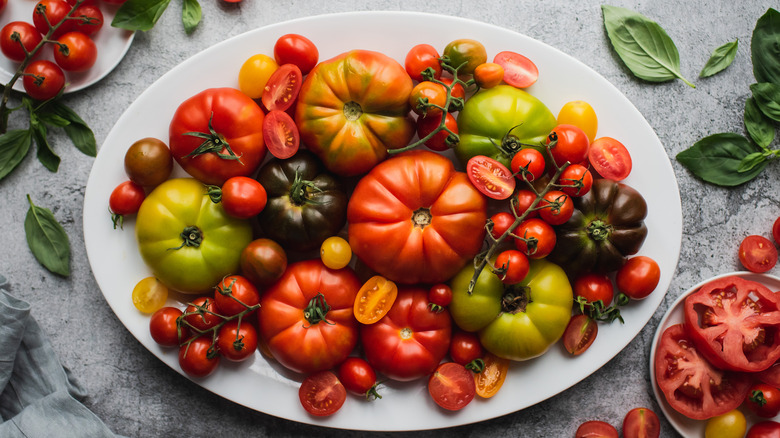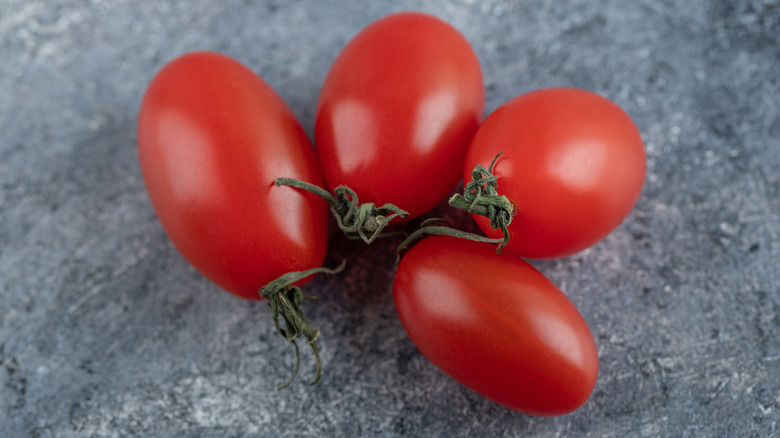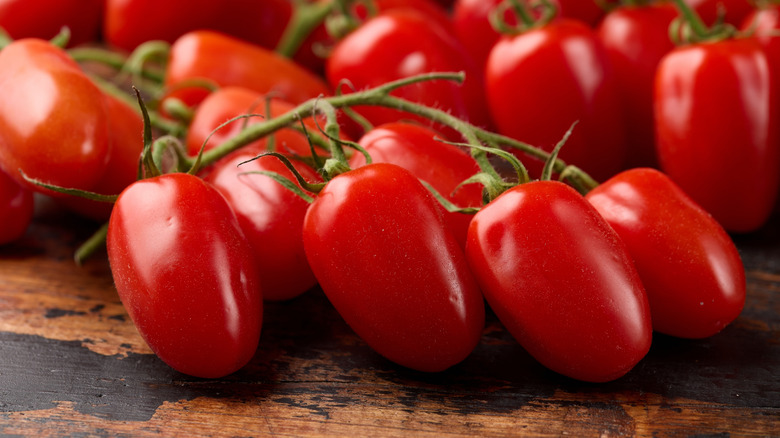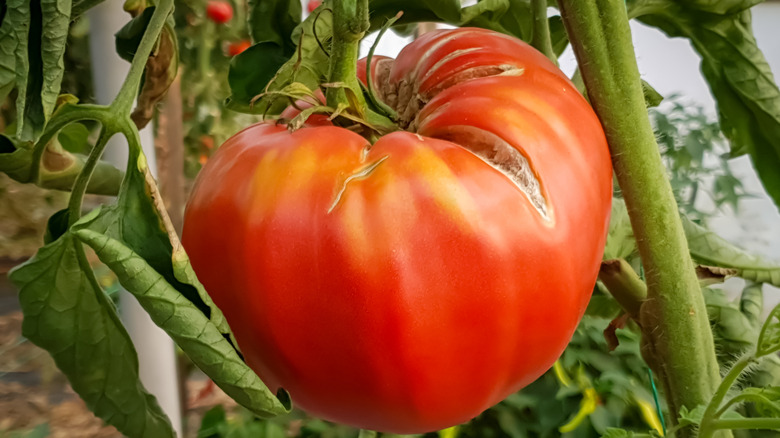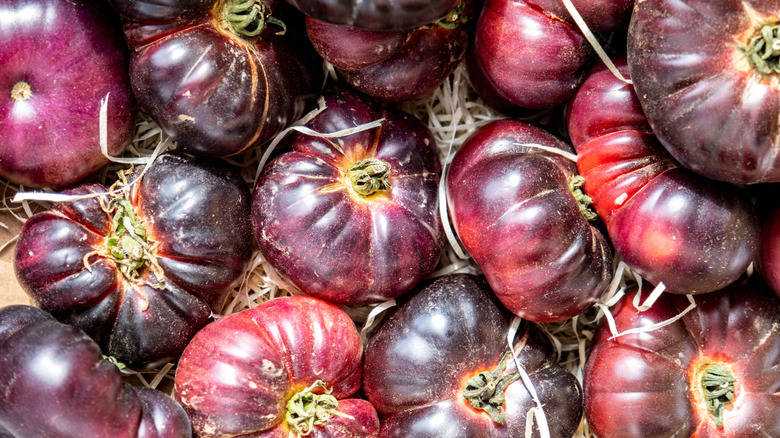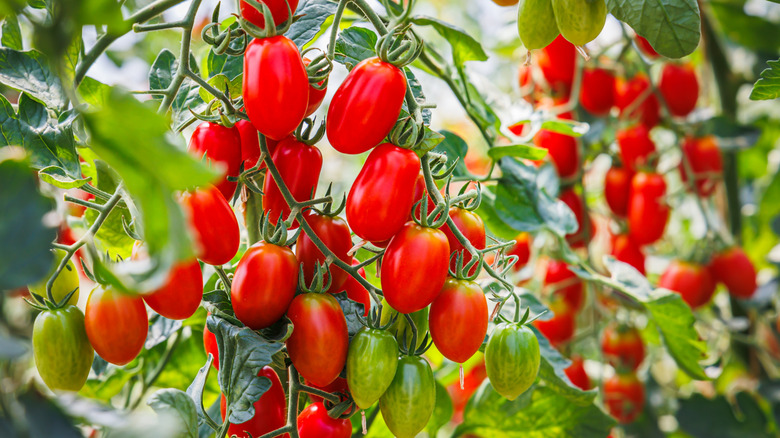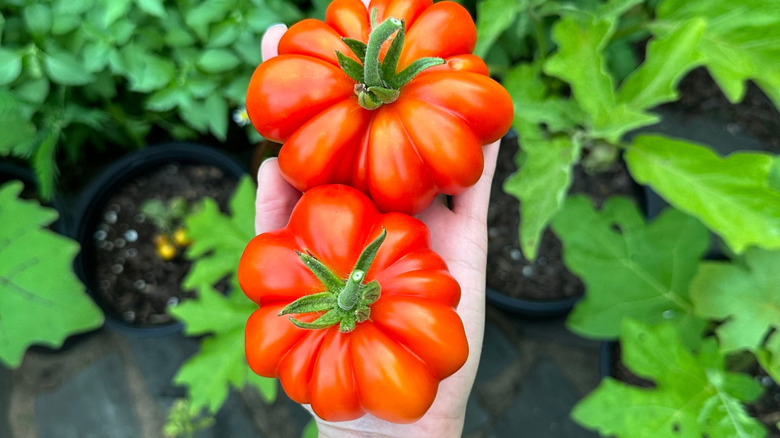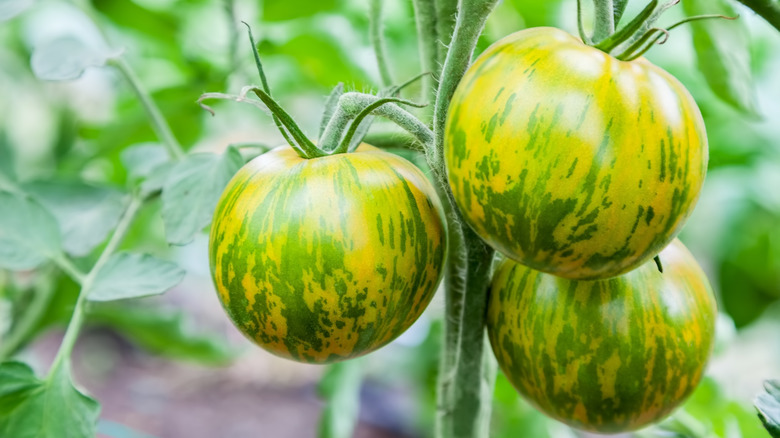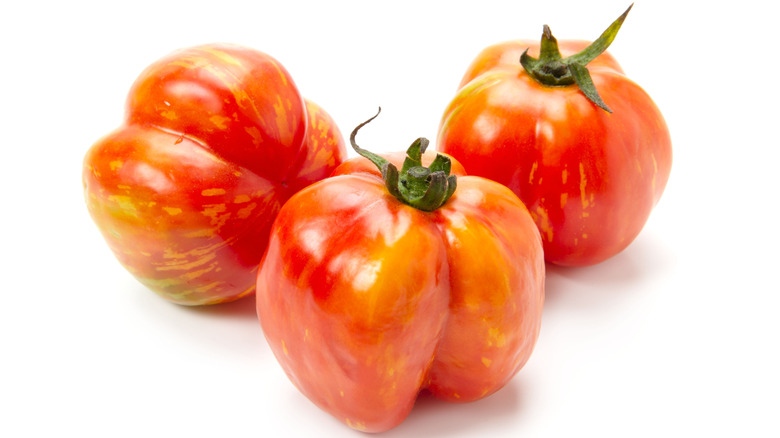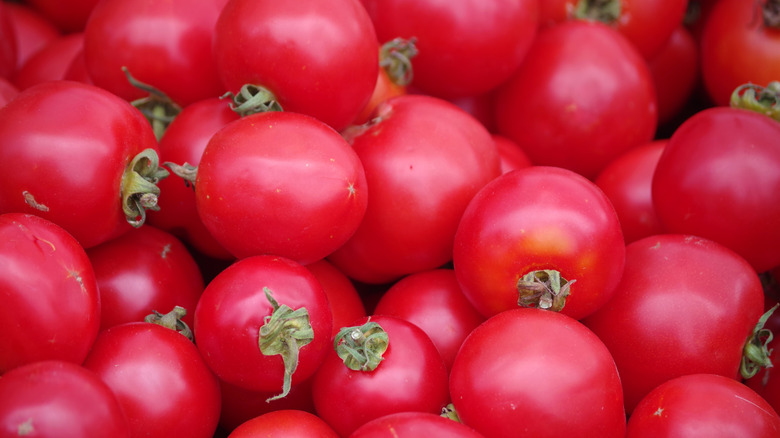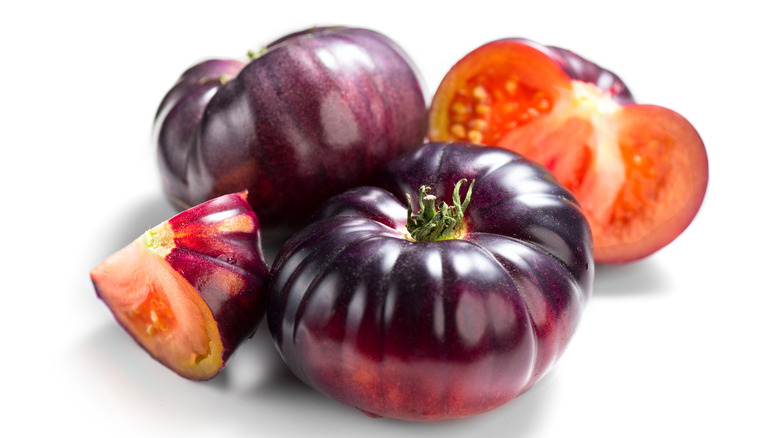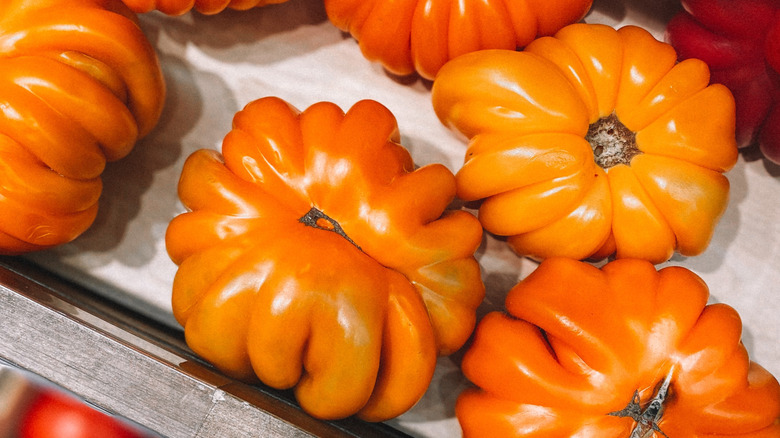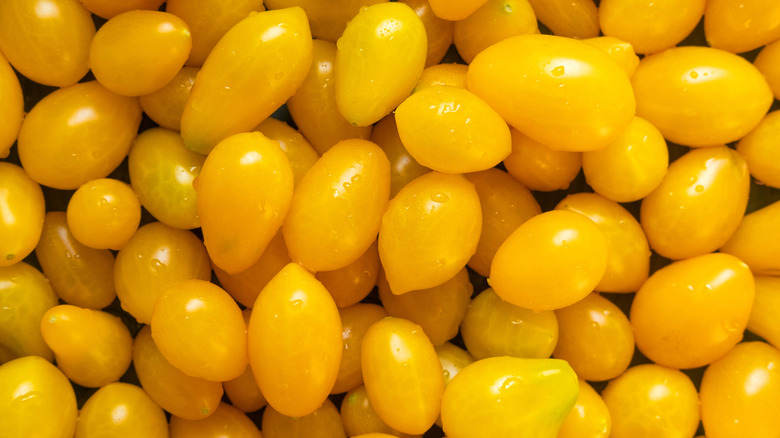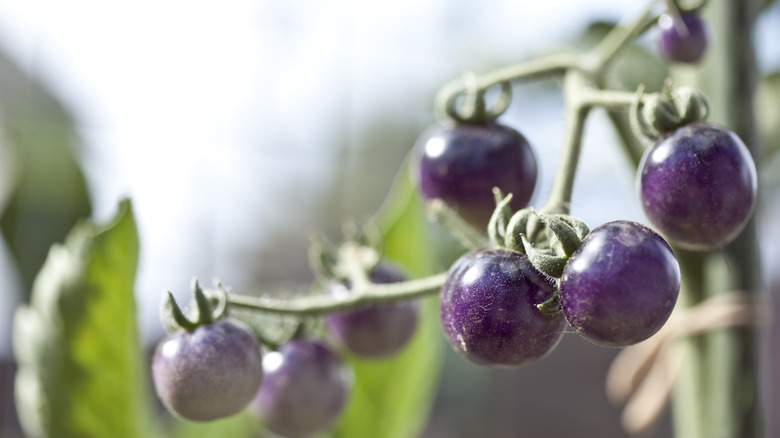13 Types Of Tomatoes You'll Wish You Tried Sooner
Whether you think of tomatoes as fruits or vegetables, the list of different varieties seems to be never-ending, and for good reason — they're delicious! Plus, they are super versatile and seamlessly blend into an infinite number of recipes. If we are being honest with ourselves, it would take a lifetime to learn about all the different types of tomatoes, and most people don't have the time or interest for something like that. After all, there are more than 10,000 different varieties. However, learning about just a few super tasty ones will serve you well in the kitchen.
From big meaty tomatoes to smaller tomatoes with easy-to-remove skins to colorful beauties to tomatoes with eye-catching patterns and shapes, this humble fruit/veggie has a lot to offer. You just have to know where and what to look for. That's why I compiled a list of some delicious tomato varieties you should know and of course, give a try. Once you learn about them, not only will you understand exactly how different one type of tomato is from the next, but you'll also know why the variety you use in any given recipe makes such a big difference in the final taste and texture.
Amish Paste tomatoes
As a whole, these tomatoes taste slightly sweet, but compared to other tomato varieties, are somewhat bland and mealy. They are also known for being juicy and meaty and are a top-selling paste tomato.
As the name suggests, Amish Paste tomatoes do in fact have ties to the Amish community. They were first commercialized in 1990 by Tom Hauch of Heirloom Seeds, who acquired them from an Amish community near Lancaster, Pennsylvania. Thanks to their juicy texture, they are good for more than just pastes. They also make a solid choice for sauces, fresh eating, and canning — which just so happens to be a major part of Amish cooking. In addition to being credited with passing along the variety for commercial purposes, it is also believed that the Amish saved this variety of tomatoes. Although, considering the community's chosen seclusion, it's unlikely they knew at the time.
If you happen to live near any Amish communities, you may be able to pick some up at one of their produce stands, but it's not unheard of to find them at farmer's markets or grocery stores, either. The seeds are also easy to acquire through Amazon and many other retailers if you want to try growing them.
San Marzano tomatoes
San Marzano tomatoes are originally from the San Marzano region of Italy, but today they are also grown in other locations. They are smaller and thinner than your typical tomato with pointed ends. When you consider their origin, it's no surprise San Marzano tomatoes are pretty much synonymous with Italian cuisine or that they are the go-to choice for tomato sauce. As such, there's a good chance you've enjoyed them before, even if you didn't know it at the time.
What makes them so great for sauces? Well, three things. First, they have fewer seeds than other varieties. Second, after cooking the skins come off with surprising ease, leading to a smoother sauce in the end. Lastly, the flavor is just right. San Marzano tomatoes are a delicious balance of sweetness, acidity, and bold tomato flavor.
Fresh San Marzano tomatoes are available in many grocery stores and the ones that don't carry them definitely have canned ones. They tend to be a bit pricier than other types of canned tomatoes, but if you're making a sauce or Italian food, they are well worth the extra cost due to the authentic Italian flavor they provide. You can also grow San Marzanos in your garden quite easily.
Brandywine tomatoes
Brandywine tomatoes are another United States variety that Rutgers University credits the Amish with saving. They were named for Brandywine Creek in Chester County, Pennsylvania but they are quite productive, so you'll find them in home gardens all over the United States now. The plants grow large, up to 10 to 15 ounces, making them easier to identify than many other varieties. Brandywine tomatoes are best known for their excellent flavor which is somehow sweet, fruity, and spicy all at the same time.
Brandywine tomatoes also come in several varieties, all of which boast different colors, further adding to their appeal. For now, you can find black, red, pink, yellow, apricot, purple, and cherry-colored Brandywines, but the family is ever expanding. Regardless of color, they are a fantastic tomato for all kinds of recipes, including sauces, pastes, roasting, and canning. Plus, they taste great fresh too and they add a nice burst of color to any dish (even if you simply opt for the basic red variety). If you're looking for an all-purpose, meaty tomato, either to grow in your garden or pick up from the market, it fits the bill. You can save the seeds from any Brandywine tomatoes you eat and use them to propagate your own plants, too.
Cherokee Purple tomatoes
Cherokee Purple tomatoes are another heirloom variety but they offer eaters a taste of something different. Compared to most tomatoes, it boasts a super sweet, rich flavor that people rave about — so much so that it consistently wins taste tests at tomato festivals. In addition, it is a beefsteak tomato so it is large and meaty, two things people love.
The name Cherokee Purple sums up two of the main characteristics of this type of tomato. For starters, the Cherokee tribe is credited with passing this variety down and ensuring its preservation, specifically in the Tennessee region. Secondly, the word purple wasn't added to the name for no reason. Both the flesh and skins of these tomatoes have a rich hue that ranges from dusky pink to deep purple. Some are more purple than others, but the shade is there nonetheless.
Pair the alluring purple color with the deliciously sweet taste and you have a tomato that's bound to be the star of many dishes. If you're looking for a unique tomato for salads, crostinis, sandwiches, and more, the Purple Cherokee is a fantastic pick. They aren't easy to find at the grocery store, but they grow well in most regions of the United States and they are good producers, so they could make an outstanding addition to your garden.
Roma tomatoes
There are probably a lot of things you don't know about tomatoes, but most people have, at the very least, heard of Roma or plum tomatoes — they are the same thing. Why? Well, they are meaty, almost seedless, and the plants produce compact vines with high yields, so they are great for growers and a broad range of recipes. Oh, yeah, the plants resist wilting and pests, too, so they are a grower's dream. Due to the name, you may think Roma tomatoes come from Italy, but that isn't the case. Instead, they were created in Maryland in 1955. They were bred by crossing San Marzano tomatoes with Red Top tomatoes and, boy, did it pay off.
Roma tomatoes are pear-shaped with thick skins and less moisture than other tomatoes. As such, they are a classic choice for paste. They also excel in salsas and sauces and are great for canning. Plus, the seed sacks are easy to remove before cooking. As noted, there aren't many to begin with, but the ease of removal is just one more reason they are a fantastic variety for cooking.
Costoluto Genovese tomatoes
Costoluto Genovese tomatoes are popular in Italy, but not so much in the United States. It isn't because they lack in any way, though. These beautiful tomatoes are shaped like a slightly flattened, bright red globe with lots of deep, vertical ridges. As a type of beefsteak tomato, the fruits are fairly large, too. If that wasn't eye-catching enough, the unique shape also makes sliced pieces of the fruit look like flowers.
In addition to its unique appearance, Costoluto Genovese tomatoes are delicious. They have a fruity flavor with mild sweetness and balanced acidity. They are also aromatic, which only improves flavor and overall appeal. As noted, these glorious tomatoes aren't easy to find in the States, but lucky us, they are hardy enough that most of us can grow them at home. They do well in a garden, pots, and of course, greenhouses, too. As a bonus, they are heirloom tomatoes, too — so you can save any seeds you get from the tomatoes and replant them next season.
Costoluto Genovese tomatoes are thought to have been first cultivated in the 18th century in Piedmont, Italy, which is slightly northwest of Genoa. Today, they are still popular in Italian gardens and you'd be wise to jump on the bandwagon.
Green Zebra tomatoes
Splotched with bright green and yellow stripes, the Green Zebra tomato is another variety that instantly catches your eye. The medium-sized fruits have a distinct flavor and aroma that is tantalizingly acidic. The acidity is also complemented by a touch of fruitiness and sweetness. All combined, these flavors add a nice zing to salads and other fresh recipes. Of course, their unique appearance makes dishes look great, too.
Created by Tom Wagner in the United States, Green Zebra tomatoes are great for home gardens. The plants are very hardy, low maintenance, have a high yield, and thanks to their heirloom status, you can easily harvest the seeds for further propagation. What more could you want? If you try your hand at growing them yourself, just make sure to keep them protected from rain because the fruits could burst in a heavy downpour.
In addition to Green Zebras, these unique tomatoes are also available in other enticing colors, including black, apricot, red, and purple. If you desire a tomato that makes a statement with its appearance alone, Zebra tomatoes make an outstanding choice.
Striped Cavern tomatoes
Due to their markings, Striped Cavern tomatoes look a lot like zebra tomatoes at first glance, but they are actually a breed all their own. Yes, they have stripes, but they are larger than most zebra tomatoes and they also have deep ridges, something zebra tomatoes lack. In addition, Striped Cavern tomatoes have a mostly hollow interior. There is still a small cluster of seeds in the center, but the fruit doesn't completely fill in the space between the seeds and the fleshy exterior.
Striped Cavern tomatoes are relatively mild compared to other tomatoes, but the taste is still pleasing. Thanks to the cavernous shape and thick walls of these tomatoes, they are a favorite for stuffing. They also hold up really well on the grill. The mild flavor also means they are quite versatile, so feel free to go wild with creative filling ingredients. Anything from ricotta and sausage to rice and potatoes to Gruyère with bread crumbs makes a drool-worthy choice.
Striped Cavern tomatoes are another variety we can thank Tom Wagner for. He first named them Schimmeig Stoo, but that translates from Manx (the language of the Isle of Man) to Striped Cavern. You may also hear them being called Schimmeig Striped Hollow tomatoes.
Early Girl tomatoes
Originally from France, Early Girl tomatoes were first brought to the United States in 1975. Since then, they became wildly popular for several reasons: They are flavorful, produce tomatoes quickly, and the plants are not only easy to grow, but they are highly productive to boot. In just 52 days, many plants develop harvestable fruits. To top it all off, they fare well in a wide range of temperatures, so they can be grown in anything from a hot and dry climate to one that gets as low as 40 F. They even thrive in fluctuating temperatures, which are common in mountain and desert regions. As long as the plants get ample sunshine, like six to eight hours a day, they'll do their thing, and they'll do it quickly.
Early Girl tomatoes feature a concentrated flavor with a rich sweetness and balanced acidity. They are also aromatic and the bright red globes are meaty, making them an all-around crowd-pleaser. Whether you're making a sandwich, salad, sauce, or something else entirely, Early Girl tomatoes are up for the job.
Better Boy tomatoes are similar to Early Girl tomatoes in shape and color, but they lag behind by about 18 days when it comes to producing fruit. Better Boys are larger, which probably accounts for the longer growth cycle, but if you desire a super fast-producing tomato plant, Early Girl is your best bet.
Blue Beauty tomatoes
Like many other types of tomatoes, the name says it all with Blue Beauties. Each tomato is a red fruit with sapphire blue shoulders that become deep purple-red or almost black as they ripen — and, yes, they are indeed beautiful. They also have a sweet, rich flavor with a moderate amount of acidity. As a result, they are good for cooking, including roasting or enjoying fresh. In addition, the blue color of these tomatoes is the result of anthocyanin pigment in the skin, which is the same thing that gives blueberries their color. Just like with blueberries, this makes Blue Beauties high in antioxidants. So not only are they pretty and tasty, but they are good for you, too.
Created at Oregon State University in the 1960s, Blue Beauty tomatoes are a cross between both wild and cultivated species native to the Galapagos Islands and Chile. Regardless of how they came about, they excel regarding crack and sunburn resistance. The plants also give growers a high yield, so they are a nice pick for home gardens. However, they prefer warmer climates and won't tolerate frost, so you'll need to keep them in a greenhouse during colder seasons if you live in a cold climate. The popularity of Blue Beauties is only increasing, so you might be able to find them at farmer's markets if you're not up for growing them yourself.
Orange Accordion tomatoes
Orange accordion tomatoes are huge and man are they pretty. As you'd expect, they are bright orange, but they also have deep ridges, further enhancing their aesthetic appeal. When we say they're big, we mean like mini pumpkin big. Seriously, each tomato can easily weigh 20 ounces. This makes them super meaty, and juicy. They also boast a sweet, fruity flavor that is undeniably delicious.
Orange Accordion tomatoes don't have a ton of seeds, so they are great for both slicing and sauces. Many Orange Accordions are also fairly hollow, so they are a shoo-in for stuffed tomato recipes, as well. Really, no matter how you slice it (pun intended) they truly shine in a world of recipes.
So, if you want your garden to be the envy of all your friends, planting Orange Accordion tomatoes is a surefire way to catch everyone's attention. The one thing you should know before diving right in though is that due to the enlarged size of Orange Accordions, they do take a bit longer to produce harvestable fruit than other varieties of tomatoes. Even so, something tells us the wait will be more than worth it when you slice into your first tomato and get a taste of its juicy goodness.
Pear or Teardrop tomatoes
The pear or teardrop tomato variety has been around since the 1700s and as such, is one of the oldest American heirlooms. Even so, it isn't the most well-known. They are similar in size to cherry tomatoes (about 1 inch), but their unique shape makes them easily distinguishable. As the name suggests, they resemble a pear — just in miniature form. They also come in two colors, red and yellow, and you will often find the seeds for both colors mixed in one seed packet, so there's no need to choose one over the other when it comes time to plant your next garden. Actually, a mix of both leads to a nice balance of flavors.
Red Teardrop tomatoes taste sweet and tangy and the texture is firm, yet juicy on the inside. Yellow Teardrop tomatoes are also firm and juicy, but their flavor is richer and sweeter. They also have lots of seeds. Whether you decide to enjoy red and yellow Teardrop tomatoes together or separately, they make a wonderful addition to salads and more. If you are one of those people who loves the feeling of a cherry tomato popping in your mouth when you bite into it (many people do), Teardrop tomatoes are a great way to branch out from the norm while still getting the same sensory feeling. Flavor-wise, they are also more mild than cherry tomatoes, so they won't overpower a recipe.
Purple tomatoes
The Purple Tomato is a genetically modified crop and it has been in the works for about 20 years. Experts at Norfolk Plant Sciences managed to add color genes from a snapdragon flower to a tomato plant and the result is the Purple Tomato. One look at these small cherry-sized tomatoes and you'll see the name is fitting because both the flesh and the skins are a deep, vibrant shade of purple, so much so that they almost look fake. So, what do Purple Tomatoes taste like? Actually, the flavor is quite similar to a red tomato, but they are less acidic and a touch sweeter and richer.
According to NPR, "the Purple Tomato is the first genetically modified food crop to be directly marketed to home gardeners," and it just became available in early 2024. Similar to a Cherokee Purple, Purple Tomatoes have high levels of anthocyanin, which not only gives them their color but also promotes health. In fact, the goal in creating the Purple tomato was to elevate it to the status of a superfood, like other foods with the same color (like eggplant, blueberries, and blackberries). Pretty cool, right?

